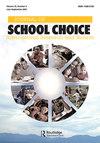The Termination of Publicly Funded Private School Contracts: Supply and Demand Side Effects
Q2 Social Sciences
引用次数: 0
Abstract
ABSTRACT We evaluate the demand and supply side effects of a policy which cuts funding to a significant portion of publicly funded private classes in Portugal, Contratos de Associação (AC), in which students do not pay tuition fees and are under the same admission criteria as in Public Schools – i.e., these private schools cannot select students based on their socioeconomic status or prior achievement. This policy established that from 2016/17, Private school classes would no longer receive Contratos de Associação funding if the government deemed that there were enough nearby Public Schools with capacity to absorb the new student cohorts. Compared to the pre-reform student cohort, we find that affected students changed the demand patterns for different types of schools: both the number of Public school classes and regular Full-Fee Private School classes increased, but the rise in the former was larger in absolute terms. Nevertheless, this pattern of movements was heterogenous across different sub-groups of the student population. While non-low-income students switched both to Public and Private school classes, we verify practically a one-to-one movement of the low-income student cohort from AC schools to Public schools only. On the supply-side, we find that the decrease in AC schools was not fully compensated by the increase of schools that are now under different Private School systems and that some of these schools later shut down.公立私立学校合同的终止:供需副作用
摘要:我们评估了一项政策的需求和供应副作用,该政策削减了葡萄牙大部分公共资助私立课程的资金,即Contratos de Associação(AC),在该政策中,学生不支付学费,并且与公立学校的录取标准相同,即。,这些私立学校不能根据学生的社会经济地位或先前的成绩来选择学生。该政策规定,从2016/17年起,如果政府认为附近有足够的公立学校有能力吸收新的学生群体,私立学校的班级将不再获得Contratos de Associação的资助。与改革前的学生群体相比,我们发现受影响的学生改变了不同类型学校的需求模式:公立学校班级和普通全日制私立学校班级的数量都有所增加,但前者的绝对增长幅度更大。然而,这种运动模式在学生群体的不同子群体中是异质的。虽然非低收入学生同时转到公立和私立学校上课,但我们实际上验证了低收入学生群体从AC学校到公立学校的一对一流动。在供应方面,我们发现,AC学校的减少并没有被现在处于不同私立学校系统下的学校的增加所完全弥补,其中一些学校后来关闭了。
本文章由计算机程序翻译,如有差异,请以英文原文为准。
求助全文
约1分钟内获得全文
求助全文

 求助内容:
求助内容: 应助结果提醒方式:
应助结果提醒方式:


